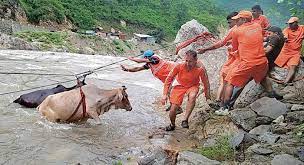Disaster Management Plan (DMP) for Protecting Animals and Preventing and Mitigating loss of Livestock Resources during various Disasters :National Disaster Management Plan for Animals
Disasters affect human as well as animals’ activities. Livestock population is the first to be affected in the precarious situations due to various disasters.
Indian government released a national disaster management plan for animals. Under the plan, rescue and relief of animals will now be an integral part of disaster operations in the country. The plan for the first time ensures that animals will be included in disaster preparations, potentially saving millions of animals’ lives and building the resilience of the communities that depend on them.
Which authority prepared the National Disaster Management Plan for Animals (DMP)?
- DMP was prepared by Department of Animal Husbandry, Dairying & Fisheries.
- DMP was brought out after wide range of consultation and elaborate discussion with different stakeholders such as National Disaster Management Authority, National Disaster Response Force, National Institute of Disaster Management, various State Governments and knowledge Institutions.
- The plan is a joint effort of the National Institute of Disaster Management (NIDM), the World Animal Protection and the Policy Perspectives Foundation (PPF).
DMP: Three Parts
Department of Animal Husbandry, Dairying & Fisheries has prepared and launched Disaster Management Plan (DMP) for protecting animals and preventing and mitigating loss of livestock resources during various disasters. DMP is divided into three parts:
- Pre-disaster preparedness
- Disaster response
- Post-Disaster Plan.
- Pre-disaster preparedness includes detailed action plan relating to dissemination of early warning, identification of vulnerability amongst livestock, animal vaccination, feed and fodder supply and capacity building of different stake-holders in disaster management etc.
- Disaster response component includes strategy/action plan relating to effective and prompt response, rescue of livestock, feed & fodder supply, measures against epidemics and diseases and maintenance of Sanitation etc.
- Post disaster component include strategy for treatment of sick animals, disease surveillance, disposal of carcass, restoration and restocking of livestock population.
DMP aims to supplement the efforts of States/UTs in managing disasters and lays down the broad guidelines for management of animal during disasters like drought, floods, cyclones, earthquakes and other man-made disasters etc. in the states/UTs.
Why DMP for animals?
- Animals are often the forgotten victims of disasters.
- Government figures reveal that as many as 1.98 lakh cattle had lost their lives in floods over the past three years during 2013-15.
- In India, animals are at the heart of everything, be it family, culture and livelihood, animals are an intrinsic part of our lives. It’s ironical that animals were missing in the picture till now.
- DMP brought out standard operating procedures (SOPs) that are to be followed by the disaster management professions across the country for protection of animals during disasters including floods, landslides and earthquake.
Disasters have a significant impact on animals in India
Weather-related disasters cause massive losses of life and property in India. Animals are not spared.
Every year nearly one million cattle are lost to floods through heavy rains. Around 55% of India’s buffaloes, 38% of its cattle, 41% of its goats, and 47% of its pigs are exposed to floods, which regularly devastate farmlands.
At the other extreme, 44% of the country’s livestock live in drought-affected areas.
Cyclones also kill many animals in India. In 1999, 3,205,689 animals (mainly cattle, small animals, and poultry birds) were lost in the Orissa Super Cyclone in Odisha state. The Odisha State government drew the lessons from this terrible disaster as they prepared for 2013’s Cyclone Phailin. They conducted India’s largest evacuation in 23 years – evacuating nearly 1.2 million people and 30,000 animals.
Including animal protection in policies and plans
Protecting animals and safeguarding livelihoods requires proper planning. India is one of the first countries in the world to integrate animals into its national disaster management plans, working closely with World Animal Protection (WPA) to do so. Such plans are central to protecting animals on a large scale. They are also a requirement of the UN’s Sendai Framework.
India’s National Disaster Management Authority (NDMA) and the Department of Animal Husbandry, Dairy and Fisheries (DAHDF) issued these plans in 2016.
- The NDMA plan offers a framework and direction to all government agencies covering all phases of the disaster management cycle. World Animal Protection provided recommendations to NDMA on integrating animal-related components into the plan.
- The DAHDF national disaster management plan specifically spells out how to protect animals before, during, and after disasters. DAHDF is responsible for farm animals/ livestock, poultry, and fisheries and worked closely with WPA technical experts to prepare the plan.
The national policy on disaster management has a dedicated section on animal care in Chapter 7-Response: “Animals both domestic and wild are exposed to the effects of natural and man-made disasters. It is necessary to devise appropriate measures to protect animals and find means to shelter and feed them during disasters and their aftermath, through a community effort, to the extent possible.”
Animals also have a strong place in Indian law, but none specifically requiring their protection during disasters. They are protected in the country’s constitution – quoted above; in The Prevention of Cruelty to Animals Act of 1960 consolidated in 1982, and in The Wildlife Protection Act of 1972.
“It shall be the duty of every citizen of India […] (g) to protect and improve the natural environment including forests, lakes, rivers, and wildlife, and to have compassion for living creatures…” Constitution of India Section 51 A
Improving disaster loss data collection
To further mitigate the impact of disasters on animals, we need to accurately measure losses. Yes, as of today, there is no data collection system in India to assess a disaster’s impact on animals. WPA is working with the Indian government to address this. Such measures would help fulfill the requirements of the Sendai Framework to quantify the ‘number of people whose livelihoods were disrupted or destroyed attributed to disasters’ [B.5].
Finally, we need to turn plans into action. This remains challenging in the absence of national coordination and dedicated resources. As we celebrate World Food Day, let us not forget that the protection of animals in disasters is critical to strengthen food security and resilient livelihoods.
After wide ranging consultation and elaborate discussion with different stakeholders such as National Disaster Management Authority, National Disaster Response Force, National Institute of Disaster Management, various State Governments and knowledge Institutions, the Department of Animal Husbandry, Dairying & Fisheries has prepared and launched Disaster Management Plan (DMP) for protecting animals and preventing and mitigating loss of livestock resources during various disasters.
DMP is divided into three parts a) Pre-disaster preparedness, b) Disaster response and c) Post-Disaster Plan. Pre-disaster preparedness includes detailed action plan relating to dissemination of early warning, identification of vulnerability amongst livestock, animal vaccination, feed and fodder supply and capacity building of different stake-holders in disaster management etc. Disaster response component includes strategy/action plan relating to effective and prompt response, rescue of livestock, feed & fodder supply, measures against epidemics and diseases and maintenance of Sanitation etc. Post disaster component include strategy for treatment of sick animals, disease surveillance, disposal of carcass, restoration and restocking of livestock population.
DMP aims to supplement the efforts of States/UTs in managing disasters and lays down the broad guidelines for management of animal during disasters like drought, floods, cyclones, earthquakes and other man-made disasters etc. in the states/UTs.
This information was given by the Minister of State for Agriculture and Farmers Welfare, Shri Sudarshan Bhagat today in a written reply to a Lok Sabha question.
Disaster Management Plan (DMP) for protecting animals and preventing and mitigating loss of livestock resources during various disasters
PROTECTING LIVESTOCK DURING DISASTER IN INDIA
https://apsdma.ap.gov.in/files/3273f87737c9e8d39daa3c798ce202c5.pdf
https://www.basu.org.in/wp-content/uploads/2018/06/handbook-of-disaster-management.pdf




